Blank L., Tarquin A. Engineering Economy (McGraw-Hill Series in Industrial Engineering and Management)
Подождите немного. Документ загружается.


SECTION 11.2 Economic Service Life
Column
D:
Capital recovery is the
AW
of
the
$l3,000
investment (cell B2) in year 0 for
each year
1 through 5 with the estimated
MY
in that year. For example,
in
actual
numbers, the cell-reference
PMT function
in
year 5 shown on the spreadsheet reads
PMT(1 0%,5, 13000, - 0), resulting in $- 3429. This series
is
plotted in Figure 11-2b
as
the middle curve, labeled capital recovery in the legend.
Column
E:
The NPY function embedded
in
the PMT function obtains the present
worth
in
year 0
of
all
AOC estimates through year k. Then PMT calculates the
AWof
AOC over the k years. For example,
in
year 5, the PMT
in
numbers is
-PMT(1O
%,
5,NPV(10%,C5:C9)+0). The 0
is
theAOC in year 0;
itis
optiona
l.
The
graph plots the
AW
of
AOC curve, which constantly increases in cost because the
AOC estimates increase each year.
Comment
The capital recovery curve
in
Figure
ll-2b
(middle curve) is not a true concave shape
because the estimated market value changes each year.
If
the same MY were estimated for
each year, the curve would appear like Figure 11-1. When several total
AW
values are
approximately equal, the curve
wi
ll be fiat over several periods. This indicates that the ESL
is
relatively insensitive
to
costs.
It is reasonable to ask about the difference between the
ESL
analysis above
and the AW analyses performed in previous chapters. Previously we
had
an esti-
mated
lif
e
of
n years with associated other estimates: first cost in year 0, possibly
a salvage value in year
n, and an AOC that remained constant or varied each year.
For all previous analyses, the calculation
of
AW
using these estimates deter-
mined
theAW
over n years. This
is
also the economic service life when n is fixed.
In all previous cases, there were no year-by-year MY estimates applicable over
the years. Therefore, we can conclude the following:
When the expected life n is known for the challenger
or
defender, deter-
mine its A W over
n years, using the first cost
or
current
market
value,
estimated salvage value
after
n years,
and
AOC estimates. This
AW
value
is
the correct one to use in the replacement study.
It
is not difficult to estimate a series
of
market/salvage values for a new or
current asset. For example, an asset with a first cost
of
P can lose market value
at
20% per year, so the market value series for years 0, 1, 2,
...
is P, 0.8P,
0.64P,
..
. , respectively. (An overview
of
cost estimation approaches and tech-
niques
is
presented
in
Chapter
15.)
If
it is reasonable to predict the MY series on
a year-by-year basis, it can be combined with the
AOC estimates to produce
what
is
called the marginal costs for the asset.
Marginal costs (MC)
are
year-by-year estimates
of
the costs to own
and
operate
an
asset for
that
year.
There are three components to each annual marginal cost estimate:
• Cost
of
ownership (loss
in
market value
is
the best estimate
of
this cost).
• Forgone interest on the market value at the beginning
of
the year.
• AOC for each year.
395
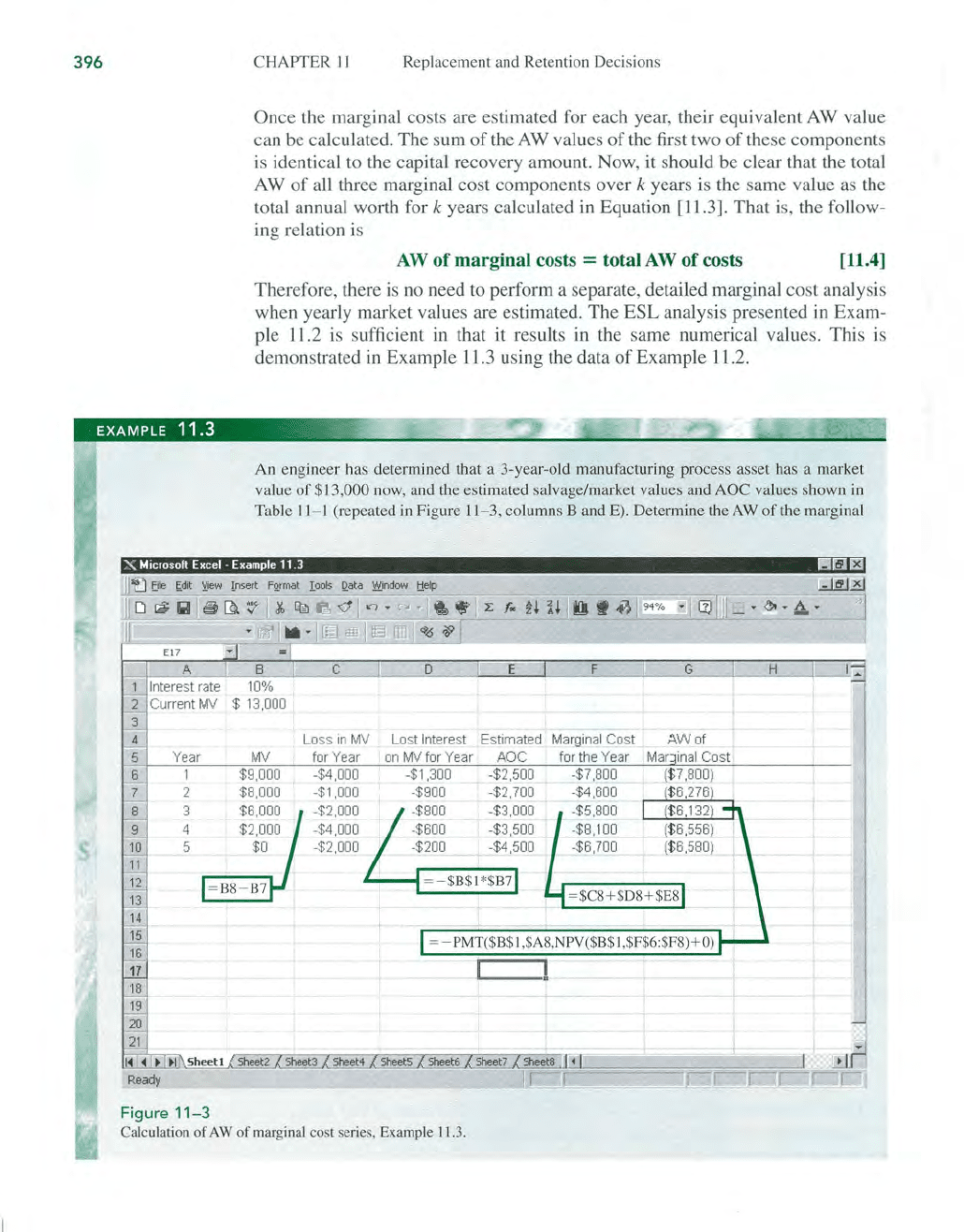
396
CHAPTER
II
Replacement and Retention Decisions
Once the marginal costs are estimated for each year, their equivalent
AW
value
can be calculated. The sum
of
the
AW
values
of
the first two
of
these components
is
identical to the capital recovery amount. Now, it should be clear that the total
AW
of
all three marginal cost components over k years is the same value as the
total annual worth for k years calculated in Equation [11.3]. That is, the follow-
ing relation is
A W
of
marginal
costs = total A W
of
costs
[11.4]
Therefore, there
is
no need to perform a separate, detailed marginal cost analysis
when yearly market values are estimated. The ESL analysis presented
in
Exam-
ple 1 J.2 is sufficient in that it results in the same numerical values. This is
demonstrated
in
Example
11
.3 using the data
of
Example 1 J .2.
EXAMPLE 11.3
',:
/
An
engineer has determined that a 3-year-old manufacturing process asset has a market
value
of
$13,000
now,
and the estimated salvage/market values and AOC values shown
in
Table
11
- 1 (repeated
in
Figure 11-3, columns B and E). Determine the
AW
of
the marginal
X M,crosoft Excel - Example
11
.3
1!Ir.;J
m
o E
Loss
in
MV
L
os
t
In
te
re
st Est
ima
te
d
Ma
rginal
Cos
t
A
Wo
f
Year
MV for
Year
on
MV
for
Y
ea
r
A
OC
fo
r
th
e Year
1 $9.000 -$4
.00
0
-
$1
,300 -$2,500 -$7,800
2
$8,0
00
-$1,000 -$900 -$2
,7
00
-$4,600
3
$6,000 -$2,000
-$800 -$3,000 -$5,800
4 $2,000 -$4,000
-$
600
-$3,500 -$8,100
5
$0 -$2,
00
0 -$2
00
-$4,500 -$6,700
=-
$B$1*$B7
= $CS+ $DS+$ES
= - PMT($B$I ,$AS,NPV($B$1,$F$6:$FS)+O)
19
20
21
,--
__
,I
I~
~ ~
~I
'
Sheet!
Sheet2 Sheet3 Sheet4 SheetS Sheet6 Sheet?
Ready
Figure
11-3
Calculation
of
AW
of
marginal cost series, Example 11.3.
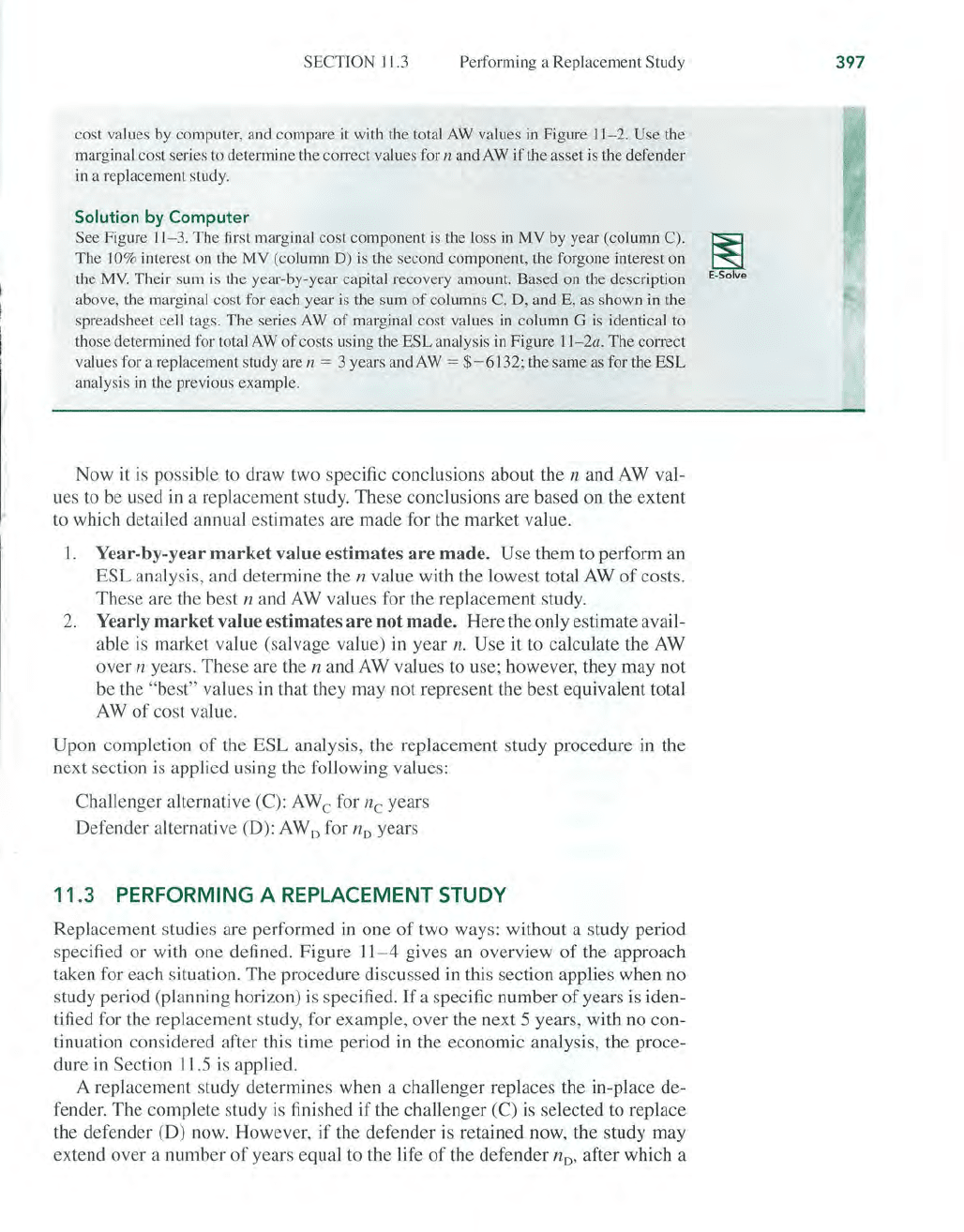
SECTION
11.3
Performing a Replacement Study
cost values by computer, and compare it with the total AW values in Figure
11-2. Use the
marginal cost series
to
determine the correct values for
nand
AW
if
the asset is the defender
in a replacement study.
Solution
by
Computer
See Figure 11-3.
The
first marginal cost component is the loss in MV by year (column C).
The
10%
interest on the MV (column D)
is
the second component, the forgone interest on
the
MY.
Their sum
is
the year-by-year capital recovery amount. Based on the description
above, the marginal cost for each year
is
the sum
of
columns C,
0,
and E, as shown in the
spreadsheet cell tags. The series
AW
of
marginal cost values in column G is identical to
those determined for total
AW
of
costs using the
ESL
analysis
in
Figure 1 I -2a.
The
correct
values for a replacement study are n = 3 years and
AW
=
$-6
I 32; the same as for the
ESL
analysis
in
the previous example.
Now it is possible to draw two specific conclusions about the
nand
AW val-
ues to be used
in
a replacement study. These conclusions are based on the extent
to which detailed annual estimates are made for the market value.
l.
Year-by-year
market value estimates are made.
Use
them to perform an
ESL
analysis, and determine the n value with the lowest total AW
of
costs.
These are the best
n and A W values for the replacement study.
2.
Yearly market value estimates are not made. Here the only estimate avail-
able
is
market value (salvage value)
in
year
n.
Use
it
to calculate the AW
over
n years. These are the
nand
AW
values to use; however, they may not
be the
"best" values
in
that they may not represent the best equivalent total
AW
of
cost value.
Upon completion
of
the
ESL
analysis, the replacement study procedure
in
the
next section
is
applied using the following values:
Challenger alternative
(C): AWe for nc years
Defender alternative (D): AW
D for n
D
years
11.3
PERFORMING A REPLACEMENT STUDY
Replacement studies are performed in one
of
two ways: without a study period
specified or with one defined. Figure
11-4
gives an overview
of
the approach
taken for each situation.
The
procedure discussed in this section applies when no
study period (planning horizon) is specified.
If
a specific number
of
years is iden-
tified for the replacement study, for example, over the next 5 years, with no con-
tinuation considered after this time period
in
the economic analysis, the proce-
dure in Section
11.5 is applied.
A replacement study determines when a challenger replaces the in-place de-
fender.
The
complete study
is
finished
if
the challenger (C) is selected to replace
the defender (D) now. However,
if
the defender is retained now, the study may
extend over a number
of
years equal to the life
of
the defender
nD'
after which a
397
~
E·Solve
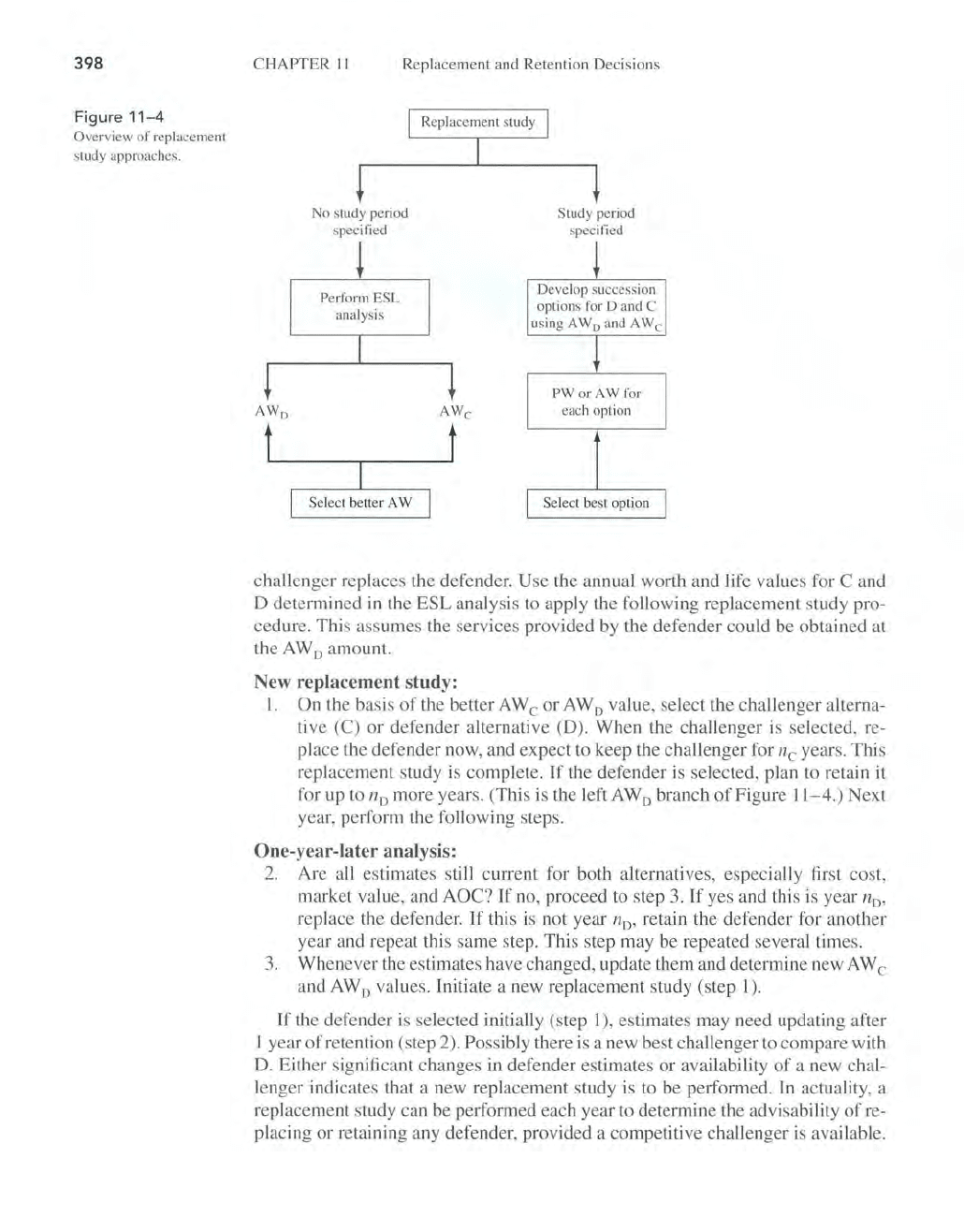
398
Fi
gure
11-4
Overvi
ew
of repla
ce
me
nt
study approaches.
CHAPTER
II
Replacement and Retention Decisions
No study pe
ri
od
sp
ec
ifi
ed
!
Perfo
rm
ESL
analysis
Study period
specified
!
Develop succession
options for D and C
us
in
g
AW
D
and AWe
PW or AW for
each option
Select best option
challenger replaces the defender. Use the annual worth and life values for C and
o determined
in
the
ESL
analysis to apply the following replacement study pro-
cedure. This assumes the services provided by the defender could be obtained at
the AW
D amount.
New replacement study:
1.
On the basis
of
the better AWe
or
A W D value, select the challenger al tern a-
tive (C)
or
defender alternative (D). When the challenger is selected, re-
place the defender now, and expect to keep the challenger for
nc years. This
replacement study is complete.
If
the defender is selected, plan to retain it
for up to
I1D
more years. (This is the left AW D branch
of
Figure
I]
- 4.) Next
year, perform the following steps.
One-year-Iater analysis:
2. Are all estimates still current for both alternatives, especially first cost,
market value, and
AOe?
If
no, proceed to step 3.
If
yes and this
is
year
I1
D
,
replace the defender.
If
this is not year
I1
D
,
retain the defender for another
year and repeat this same step. This step may be repeated several times.
3.
Whenever the estimates have changed, update them and determine new
AW
e
and
AW
D values. Initiate a new replacement study (step
I)
.
If
the defender
is
selected initially (step I), estimates may need updating after
I year
of
retention (step 2). Possibly there is a new best challenger to compare with
O.
Either significant changes
in
defender estimates
or
availability
of
a new chal-
leng
er
indicates that a new replacement study is to be performed.
In
actuality, a
replacement study can be performed each year to determine the advisability
of
re-
placing
or
retaining any defender, provided a competitive challenger is available.

SECTION 11.3 Performing a Replacement Study
Example 11.4 below illustrates the application
ofESL
analysis for a challenger
and defender, followed
by
the use
of
the replacement study procedure. The plan-
ning horizon is unspecified in this example.
EXAMPLE
11.4
:
Two years ago, Toshiba Electronics made a $15 million investment in new assembly line
machinery.
It
purchased approximately 200 units at $70,000 each and placed them in
plants
in
10
different countries. The equipment sorts, tests, and performs insertion-order
kitting
on
electronic components
in
preparation for special-purpose printed circuit boards.
This year, new international industry standards will require a $ I
6,000 retro-fit
on
each
unit, in addition
to
the expected operating cost. Due to the new standards, coupled with
rapidly changing technology, a new system
is
challenging the retention
of
these 2-year-old
machines. The chief engineer at Toshiba
USA realizes that the economics must be consid-
ered, so he has asked that a replacement study be performed this year and each year in the
future, if need
be.
At i
==
10% and with the estimates below, use both hand and computer
calculations
to
(a) Determine the
AW
values and economic service lives necessary to perform the re-
placement study.
(b) Perform the replacement study now.
Challenger: First cost:
$50,000
Future market values: decreasing by 20% per year
Estimated retention period: no more than 5 years
AOC estimates: $5000
in
year 1 with increases
of
$2000 per year
thereafter
h
Defender: Current international market value: $15,000
Future market values: decreasing by 20% per year
Estimated retention period: no more than 3 more years
AOC estimates: $4000 next year, increasing by $4000 per year
thereafter, plus the
$16,000 retro-fit next year
(c) After I year, it is time to perform the follow-up analysis. The challenger
is
making
large inroads to the market for electronic components assembly equipment, espe-
cially with the new international standards features built
in.
The expected market
value for the defender
is
still $12,000 this year, but it is expected to drop to virtually
nothing
in
the
future-$2000
next year on the worldwide market and zero after that.
Also, this prematurely outdated equipment is more costly to keep serviced, so the es-
timated
AOC next year has been increased from $8000 to $12,000 and to $16,000 two
years out. Perform the follow-up replacement study analysis.
Solution by Hand
(a) The results
of
the ESL analysis, shown in Table 11-2, include all the MV and AOC
estimates for the challenger
in
part (a)
of
the table. Note that P
==
$50,000 is also
the
MV
in
year
O.
The total
AW
of
costs is for each year, should the challenger be
placed into service for that number
of
years. As
an
example, the year k
==
4 amount
of
$- 19,123 is determined using Equation [11.3]. The
AIG
factor
is
applied
in
lieu
of
the
PI
F and
AlP
factors to find the A W
of
the arithmetic gradient
399
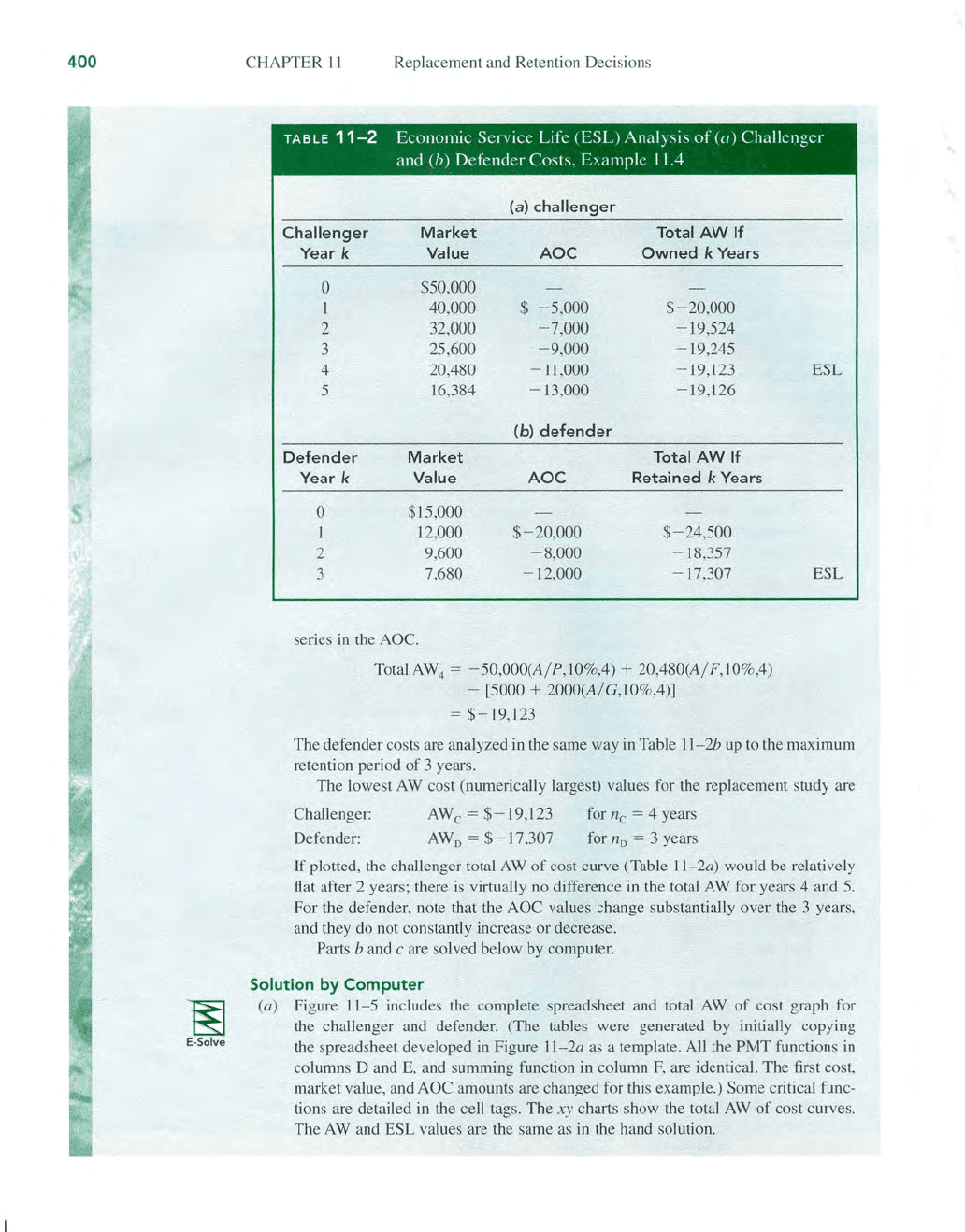
400
~
E-Solve
CHAPTER
11
Replacement and Retention Decisions
TABLE
11-2
Economic Service Life (ESL) Analysis
of
(0)
Challenger
and
(b)
Defender Costs. Example 11.4
(a) c
hallenger
Challenger
Market
Total
AW
If
Year k Value
AO
C
Owned
k Years
0
$50,000
I 40,000
$
- 5,000
$-20,000
2 32,000
- 7,000 -
19
,524
3
25
,600
- 9,000 - 19,245
4 20,480
- 11,000
-19
,123
ESL
5
16
,384 -
13
,000
- 19,126
(b)
defender
Defender
Market
Total
AW
If
Year k
Value
AO
C Retained k Years
0
$15,000
1
12
,000
$- 20,000
$-
24,500
2
9,600
- 8,000
-18
,357
3
7,680
-
12
,000
-17
,307
ESL
series
in
the AOC.
To
tal
AW
4
= - 50,000(A/P,
1O%
,4) + 20,480(A/ F,
10
%,4)
- [5000 + 2000(A/G,1O%,4)]
= $-
19
,
123
The defender costs are analyzed
in
the same way in Table 11-2b
up
to
the maximum
retenti
on
period
of
3 years_
The lowest
AW
cost (numerically largest)
va
l
ue
s for the replacement study are
Challenger:
Defender:
AW
e =
$-
19
,
123
AW
D
= $- 17,307
for
l1
e = 4 years
for
I1D
= 3 years
If
plotted, the challenger total
AW
of cost cur
ve
(Table 11
-2a)
would be relati
ve
ly
flat after 2 years; there
is
virtua
ll
y
no
difference
in
the total
AW
for years 4 and
5.
For
th
e defender, note that the AOC values change substantia
ll
y over the 3 year
s,
and they do not constantly
in
crea
se
or decrease.
Parts
ba
nd c are solved below
by
computer.
Solution
by
Computer
(a) Figure 11
-5
includes the complete spreadsheet a
nd
total A W
of
cost graph for
the cha
ll
enger and defender. (The tables were generated
by
initia
ll
y copy
in
g
th
e spreadsheet developed
in
Figu
re
11-20
as
a template. All the PMT functions
in
columns D and
E,
and summing
fu
nction in column F, are identica
l.
The
firs
t cost,
market value, and
AOC amounts are changed for
th
is example
.)
Some critical func-
tions are detailed
in
the ce
ll
tags. The
xy
charts show the total
AW
of
cost curves.
The
AW
and ESL
va
lu
es are the same
as
in
the hand sol
ut
ion.
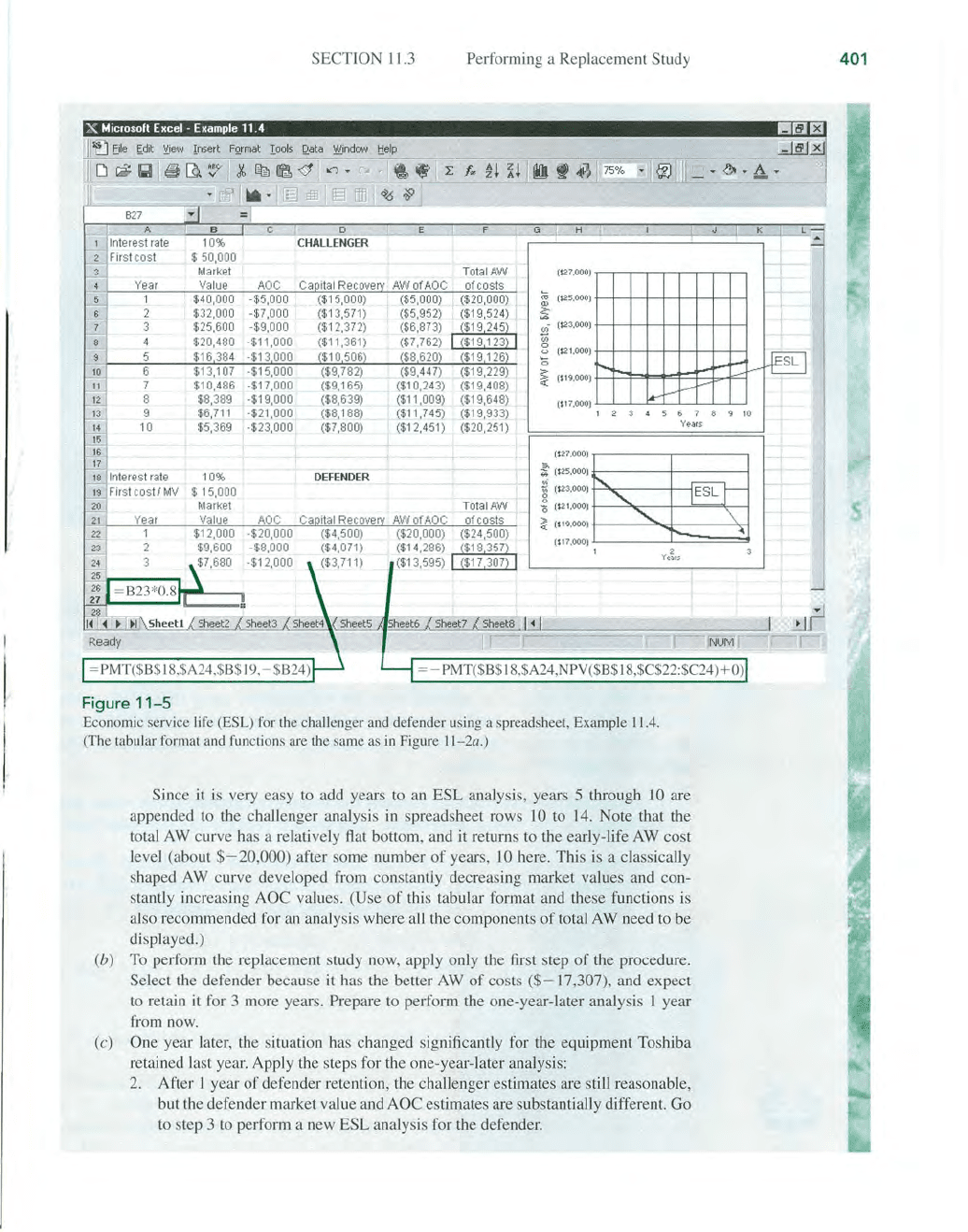
SECTION
11
.3
Perf
orming a Re
pl
acement Study
X hi ierosolt E Heel - E Hample 11.4
!!Ira
13
c 0 G H
CHALLENGER
$ 50,000
Mar
ke
l Total
AW
($
27.000)
Year
Va
lue
AOC
Ca it
al
Rec
ove
r
1
$40,0
00
-$5
,0
00 ($15,000)
ro
($
25.000)
2
$32,000 -$7,
00
0
(
$1
3,5
71
)
$
3
$25,600 -$9,000 (
$1
2,372)
(1"
; ($23,000)
$20,480
-$11
,0
00
($1
1,361)
U;
$1638
4
-$13000
($
1
0506
~
($
2 1,000)
'0
6 $13,107 -$15,000 ($9,782)
S
($19,000)
7
$10,486 -$17,000
($9,165)
c(
8 $8,389 -$19,000 ($8,639)
($
17.000
)
9 $6,
71
1 -$21,000 ($
8,
188)
10 $5,369 -$23,000 ($7
,8
00)
18
Interest rate
1
0%
DEFENDER
19
Fi
rst cos
t!
MV
$ 15,000
20
Market
Total AW
($27,
000
)
~
($25,
000)
~
(S
23,OO
O)
8
'0
($
2 1.000)
~
"'
~
21
Y
ea
r
22
1
2:J
2
24
25
AWofAOC
($20,000)
($1
4,286)
($
13,595)
......::~~,
~
($1
9.
000)
""
r-..
(J
17
.
000)
2£
= B23*0
.8
27
2S
I~
~
~I
Sheet!
Ready
= PMT($B$18,$A24,$B$ 19, - $824)
Figure
11-5
Economic service life (ESL) for the challeng
er
and defender us
in
g a spreadsheet, Example 11.4.
(The tabular format and functions are the same as
in
Figure 11-2a.)
Since it is very easy to add years to an
ESL
analysis, years 5 through 10 are
appended to the challenger analysis
in
spreadsheet rows 10
to
14. Note that the
total A W curve has a relatively flat bottom, and
it
returns to the early-life
AW
cost
level (about
$- 20,000) after some number
of
yeau
's,
LO
here. This
is
a classicaUy
shaped
AW
curve developed from constantly decreasing mau'ket values and con-
stantly increasing AOC values. (Use
of
this tabular format and these functions is
also recommended for
an
analysis where all the components
of
total AW need to be
displayed.)
(b) To perform the replacement study now, apply only the first step
of
the procedure.
Select the defender because it has the better AW
of
costs ($-
17
,307), and expect
to retain it for 3 more years.
Prepare to perform the one-year-Later analysis I year
from now.
(c)
One
year later, the situation has changed significantly for the equipment Toshiba
retained last year. Apply the steps for the one-year-later analysis:
2. After I year
of
defender retention, the challenger estimates
au'e
still reasonable,
but the defender
mau'ket value and AOC estimates
au'e
substantially different. Go
to step 3 to perform a new
ESL
analysis for the defender.
\
'lr.
,
j...
401
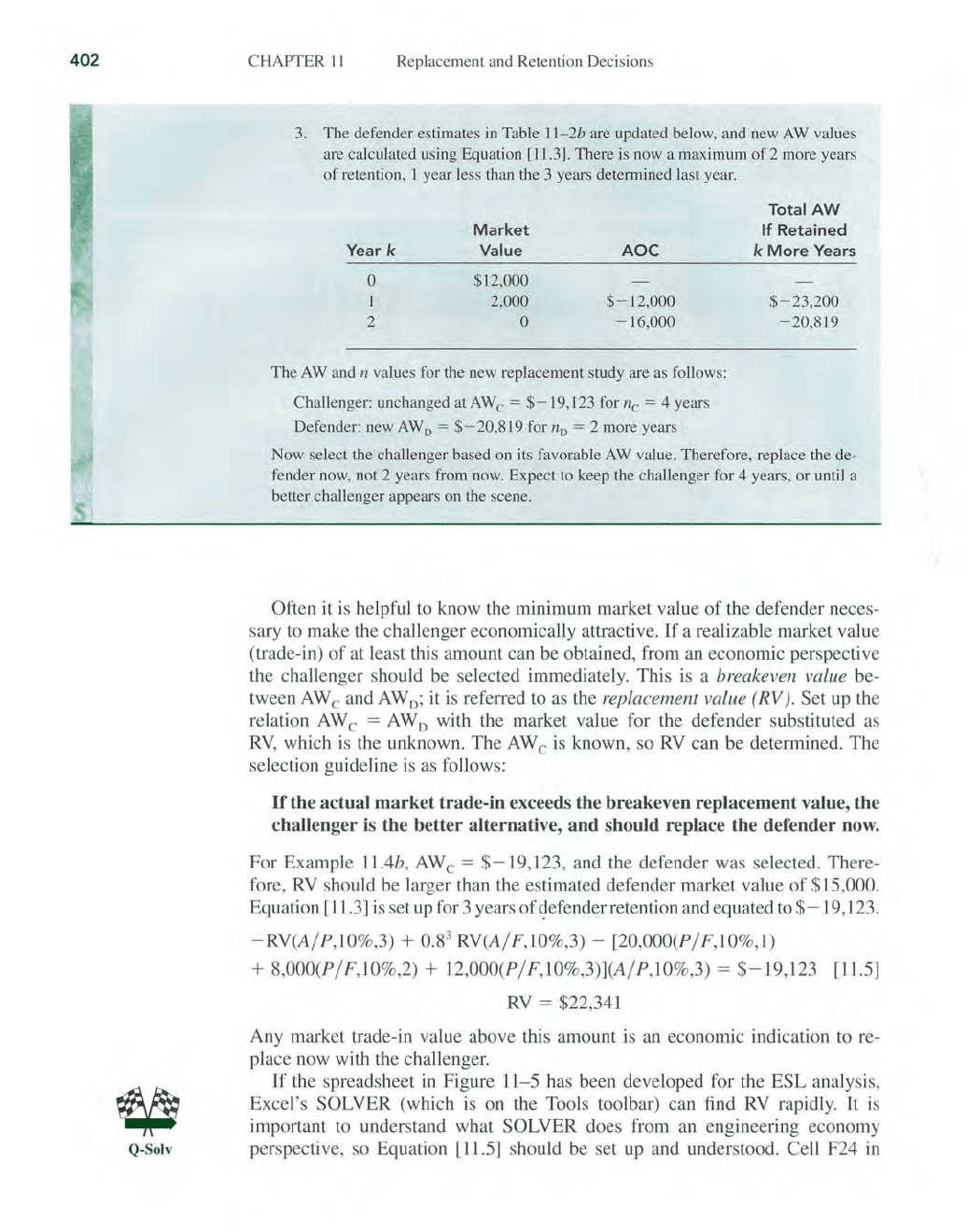
402
Q-Solv
CHAPTER
II
Replacement and Retention Decisions
3. The defender estimates
in
Table 11-2b are updated below, and new
AW
values
are calculated using Equation
[11.3]. There
is
now a maximum
of
2 more years
of
retention, 1 year less than the 3 years determined last year.
Market
Year k
Value
AOe
0 $12,000
I
2,000
$-12,000
2
0
-16,000
The
AW
and n values for the new replacement study are as follows:
Challenger: unchanged at
AW
e =
$-19,123
for ne = 4 years
Defender: new
AW
D
=
$-20
,819 for n
D
= 2 more years
Total
AW
If
Retained
k
More
Years
$- 23,200
- 20
,8
19
Now select the challenger based
on
its favorable
AW
value. Therefore, replace the de-
fender now, not 2 years from
now.
Expect to keep the challenger for 4 years, or until a
better challenger appears on the scene.
Often it
is
helpful
to
know the minimum market value
of
the defender neces-
sary
to
make the challenger economically attractive.
If
a realizable market value
(trade-in)
of
at least this amount can be obtained, from an economic perspective
the challenger should be selected immediately. This is a
br
eakeven value be-
tween
AW
e and
AW
0;
it
is
referred to
as
the replacement value (RV). Set
up
the
relation AWe
= A W 0 with the market value for the defender substituted
as
RV
, which
is
the unknown. The AWe is known, so
RV
can be determined. The
selection guideline is
as
follows:
If
the actual
market
trade-in exceeds the breakeven replacement value, the
challenger is the
better
alternative,
and
should replace the defender now.
For Example
ll.4b
,
AWe
= $
-19,123
, and the defender was selected. There-
fore,
RV
should be larger than the estimated defender market value
of
$15,000.
Equation [11.3] is set
up
for 3 years
of
gefenderretention and equated
to
$-19,
123.
-RV(A/P,1O%,3)
+ 0.8
3
RV(A/F
,
1O
%,
3)
- [20,000(P/F,10
%,
I)
+ 8,000(P/
F,l0%,2)
+
12
,000(P/F,
1O
%,3)](A/
P,l0
%,
3)
=
$-
19,123 [11.5]
RV
= $22,341
Any market trade-in value above this amount is an economic indication
to
re-
place now with the challenger.
[f the spreadsheet
in
Figure 11-5 has been developed for the ESL analysis,
Excel's
SOLVER (which is on the Tools toolbar) can find
RV
rapidly. It
is
important
to
understand what SOLVER does from an engineering economy
perspective, so Equation [11.5] should be set up and understood. Cell F24
in

SECTION
11.4 Additional
Considerations
in
a
Replacement
Study
Figure 11-5
is
the "target cell" to equal
$-]
9, 123 (the best AWe
in
F8). This is
how Excel sets up a spreadsheet equivalent
of
Equation [11.4]. SOLVER returns
the
RV
value
of
$22,341
in
cell B
19
with a new estimated market value
of
$] 1,438
in
year 3. Reflecting on the solution to Example Il.4(b), the current mar-
ket value
is
$15,000, which is less than
RV
= $22,341.
The
defender is selected
over the challenger.
Use Appendix A
or
the Excel online help function to learn
how to use
SOLVER in an efficient way. SOLVER is used more extensively
in
Chapter
13
for breakeven analysis.
11
.4 ADDITIONAL CONSIDERATIONS
IN
A REPLACEMENT STUDY
There are several additional aspects
of
a replacement study that may
be
intro-
duced. Three
of
these are identified and discussed
in
turn.
• Future-year replacement decisions at the time
of
the initial replacement study.
• Opportunity-cost versus cash-flow approaches to alternative comparison.
• Anticipation
of
improved future challengers.
In most cases when management initiates a replacement study, the question is
best framed as,
"Replace now, 1 year from now, 2 years from now, etc.?"
The
pro-
cedure above does answer this question provided the estimates for C and D do not
change as each year passes. In other words,
at
the time it is performed, step 1
of
the procedure does
answer
the replacement
questionfor
muLtipLe
years. It
is
only
when estimates change over time that the decision to retain the defender may be
prematurely reversed
in
favor
of
the then-best challenger, that is, prior to no years.
The
fir
st costs
(P
values) for the challenger and defender have been correctly
taken as the initial investment for the challenger C and current market value for
the defender
D.
This is called the opportunity-cost approach because it recog-
nizes that a cash inflow
of
funds equal to the market value is forgone if the de-
fender
is
selected. This approach, also called the conventional approach, is cor-
rect for every replacement study. A second approach, called the
cash-flow
approach,
recognizes that when C
is
selected, the market value cash inflow for the
defender
is
received and,
in
effect, immediately reduces the capital needed to in-
vest
in
the challenger. Use
of
the cash-flow approach is strongly discouraged for
at least two reasons: possible violation
of
the equal-service assumption and in-
correct capital recovery value for C. As
we
are aware, all economic evaluations
must compare alternatives with equal service. Therefore, the cash-flow approach
can work only when challenger and defender lives are exactly equal. This is com-
monly not the case;
in
fact, the
ESL
analysis and replacement study procedure are
designed to compare two mutually exclusive,
unequaL-life alternatives via the an-
nual worth method.
If
this equal-service comparison reason is not enough to
avoid the cash flow approach, consider what happens to the challenger's capital
recovery amount when its first cost
is
decreased by the market value
of
the de-
fender. The capital recovery (CR) terms
in
Equation [11.3] will decrease, result-
ing
in
a falsely low value
ofCR
for the challenger, were it selected. From the van-
tage point
of
the economic study itself, the decision for
CorD
will not change;
but when C
is
selected and implemented, this
CR
value is not reliable.
The
403
Sec.
13.
3
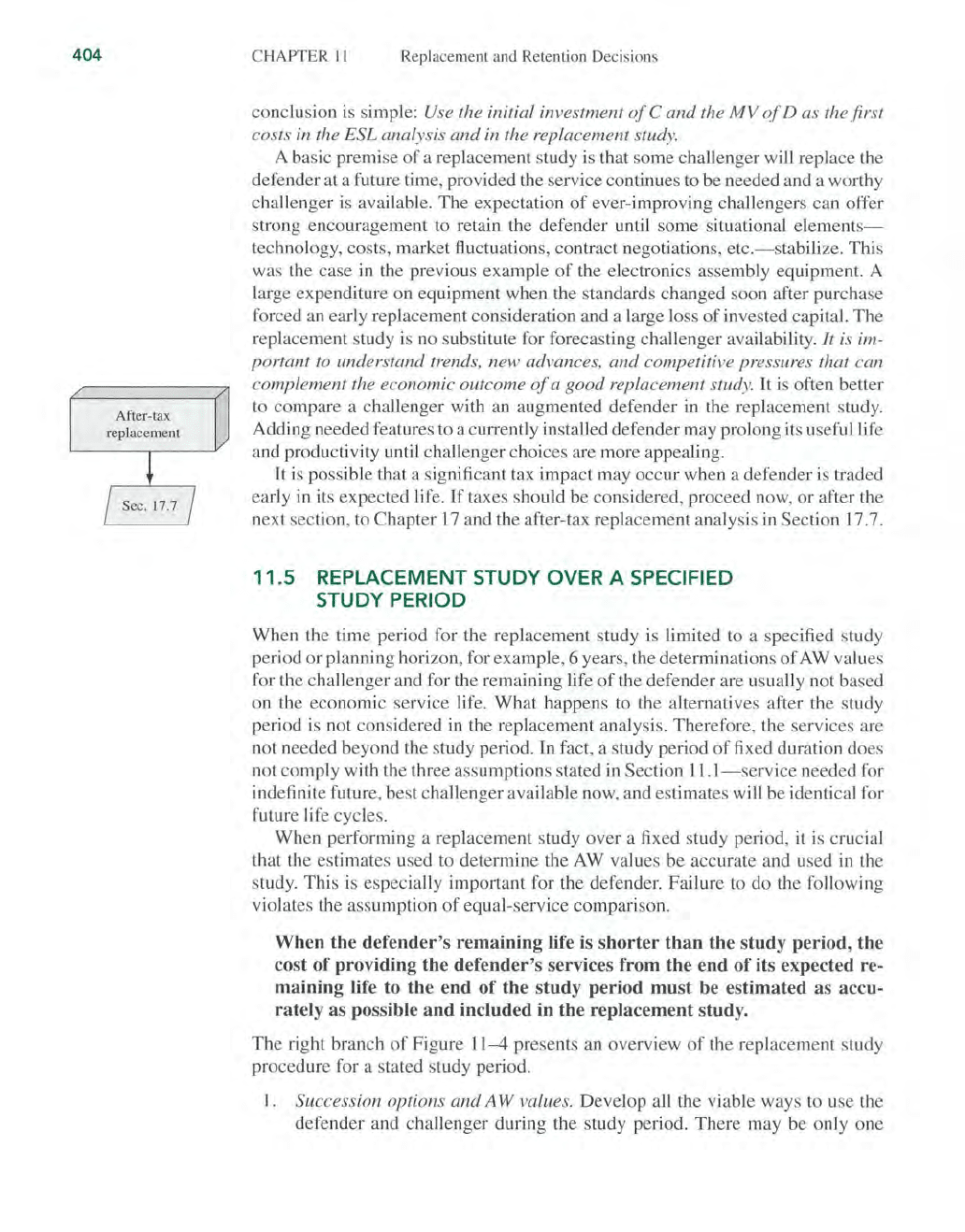
404
/
After-tax
replacement
I Sec. 17.7 I
CHAPTER
II
Replacement and Retention Decisions
conclusion is simple: Use the initial investment
of
C and the
MV
of
D as the first
costs
in
the ESL analysis and in the replacement study.
A basic premise
of
a replacement study
is
that some challenger will replace the
defender at a future time, provided the service continues to be needed and a worthy
challenger is available. The expectation
of
ever-improving challengers can offer
strong encouragement to retain the defender until some situational
elements-
technology, costs, market fluctuations, contract negotiations,
etc.-stabilize.
This
was the case in the previous example
of
the electronics assembly equipment. A
large expenditure on equipment when the standards changed soon after purchase
forced an early replacement consideration and a large loss
of
invested capital.
The
replacement study
is
no substitute for forecasting challenger availability. It is im-
portant to understand trends, new advances, and competitive pressures that can
complement the economic outcome
of
a good replacement study.
It
is
often better
to compare a challenger with an augmented defender
in
the replacement study.
Adding needed features to a currently installed defender may prolong its useful life
and productivity until challenger choices are more appealing.
ft
is
possible that a significant tax impact may occur when a defender is traded
early
in
its expected life.
If
taxes should be considered, proceed now, or after the
nex t section, to Chapter
17
and the after-tax replacement analysis
in
Section
17
.7.
11.5
REPLACEMENT STUDY OVER A SPECIFIED
STUDY PERIOD
When the time period for the replacement study
is
limited to a specified study
period or planning horizon, for example, 6 years, the determinations
of
AW values
for the challenger and for the remaining life
of
the defender are usually not based
on the economic service life. What happens to the altematives after the study
period
is
not considered
in
the replacement analysis. Therefore, the services are
not needed beyond the study period. In fact, a study period
of
fixed duration does
not comply with the three assumptions stated
in
Section 1
1.
I-service
needed for
indefinite future, best challenger available now, and estimates will be identical for
future life cycles.
When performing a replacement study over a fixed study period, it
is
crucial
that the estimates used to determine the AW values be accurate and used
in
the
study. This is especially important for the defender. Failure to do the following
violates the assumption
of
equal-service comparison.
When the defender's remaining life is
shorter
than
the study period, the
cost
of
providing the defender's services from the end
of
its expected re-
maining life to the end
of
the study period
must
be estimated as accu-
rately as possible
and
included in the replacement study.
The
right branch
of
Figure
11-4
presents an overview
of
the replacement study
procedure for a stated study period.
I.
Succession options and A W values. Develop all the viable ways to use the
defender and challenger during the study period. There may be only one
